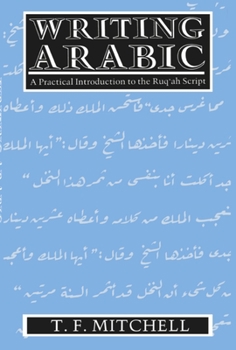Writing Arabic: A Practical Introduction to Ruq'ah Script
164 pages. This description may be from another edition of this product.
Format:Paperback
Language:English
ISBN:0198151500
ISBN13:9780198151500
Release Date:August 1979
Publisher:Oxford University Press, USA
Length:164 Pages
Weight:0.90 lbs.
Dimensions:0.4" x 6.1" x 9.7"
Related Subjects
African & Middle Eastern Arts, Music & Photography Foreign Language Foreign Language Dictionaries & Thesauruses Foreign Language Fiction Foreign Language Learning Foreign Language Study Foreign Language Study & Reference Foreign Languages History & Criticism Humanities Literature & Fiction Study & Teaching Words, Language & Grammar World LiteratureCustomer Reviews
5 ratings
Really Invaluable
Published by Thriftbooks.com User , 19 years ago
If you've been developing your Arabic handwriting by imitating the printed script used in textbooks and other printed material, you're pretty much wasting your time. The 'Naskh' script is not used by Arabs in handwriting and attempts to imitate it only end up looking amateurish. Mitchell's book is the only really good introduction into both the handwritten and calligraphic 'Ruq'ah' scripts that I know of. It has a very systematic approach, and comprehensive and thorough coverage which makes it relatively easy to locate specific details-- but since the individual sections are interdependent the student will have to work iteratively through the material front-to-back a number of times until it is completely mastered. As alluded to in a number of reviews, this book is definitely 'old school'. It is a reproduction of a typewritten and handwritten manuscript, has a pretty high 'information density' (so the book itself is correspondigly deceptively small), and is unforgiving in its use of technical terminology, demanding focused attention from the reader. Just to reiterate a point made by another reviewer, this book bears no relationship to Alif Baa at all. Alif Baa is a grammar tutorial that does not go into handwriting at all-- and vice versa, Mitchell's book presupposes quite some basic knowledge of Arabic orthography. In any case I'm surprised that someone would recommend Alif Baa under any circumstances, as that suffers, in my opinion, from a great many defects. If you are used to modern typeset textbooks with four-color graphics, sidebars, and elaborate formatting, you may be disappointed by 'Writing Arabic'. If, however, you can take this book on its own terms, you should find it a valuable and reliable resource.
The Write Stuff !
Published by Thriftbooks.com User , 20 years ago
If you seriously want to learn to write Arabic properly, this very practical manual is indispensable. It shows you how develop your Arabic handwriting step by step in order to achieve stunning results that ooze instant authenticity, and are more Arabic than an Arab's hand ! T F Mitchell has done a great service here, and it's a little surprising why this manual isn't staple as so many go astray by copying the 'naskh' (print) script, which is too much like trying to fit a square peg in a round hole. Although the essential practicality of the book is beyond reproach, it does need modernising in terms of pen technology discussions, linguistic asides, and colour/typeface. An accompanying CDROM or some type of multimedia ought to be, to use the author's language, 'de rigeur' !
Learn to write properly
Published by Thriftbooks.com User , 21 years ago
With the greatest of respect for Alif Baa and Mastering Arabic mentioned in the reviews below, neither teachs you good Arabic handwriting, and both also concern themselves with pronunciation and grammar. Writing Arabic, by contrast, concerns itself wholly with the Ruq'a script, the script most Arabs use for their everyday handwriting. The reviewers are right in saying that some knowledge of the Arabic script would be helpful (no, neccessary) before approaching this book - you need the ability to make out ordinary Arabic print (i.e. the calligraphic Naskh script) - and the reader should use this book in conjunction with another book on the Arabic language. However, for the serious student of Arabic, I can't recommend strongly enough the use of this book as soon as you know the alphabet. You'll also learn to read other people's handwriting - no easy thing. Oh, don't be put off by the 1950's typewritten English script - unlike the other books on offer, no printed Arabic appears in this book, just good handwriting. The others show a little scrappy Naskh script (an extraordinarily difficult script to write properly) and print the rest. The aim of Writing Arabic is to teach you to write Arabic clearly. [Note Summer 2005: a new book has come out that may be a more user-friendly way of learning good handwriting: Jane Wightwick and Mahmoud Gaafar's "Mastering Arabic Script" (not to be confused with the authors' "Mastering Arabic"), which also teaches ruq'a. I've not seen it yet, though. JL]
Excellently achieves its purpose.
Published by Thriftbooks.com User , 24 years ago
If you want to learn how to write Arabic so that your handwriting would even fool an Arab, there is absolutely no better book available. Most other Arabic language books teach only naskh script, which is the Arabic equivalent of block printing and looks juvenile in handwriting. The few books that actually do deal with ruqah script don't really teach the student how to develop good penmanship. Anbody seriously interested in learning to write Arabic as it is written in the modern world cannot ignore this book.
For people learning the Arabic script or trying to improve.
Published by Thriftbooks.com User , 26 years ago
The best introduction to writing in an everyday Arabic script well that I know of. What more can I say? A must for students of Arabic. It uses the ruq'a script which nine-tenths of Arabs use to write with. First published in the '50's, it's unsurpassed.




